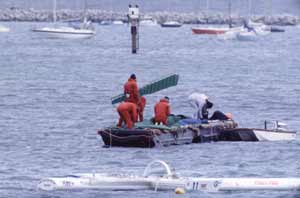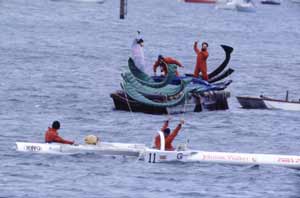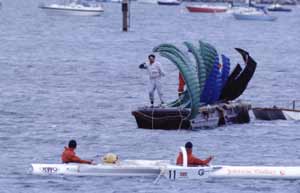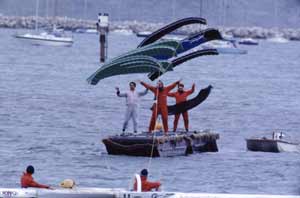Some time in the mid 1970s the Royal Yachting Association (RYA) began holding an annual autumn "Speed Week" in Portland Harbour (by Weymouth, UK) to set and then improve speed under sail on a measured 500 metre course. They set records for several sail area classes and the inaugural meets were well reported in the sailing press. This is a resume of one amateur campaign, written from memory and so some details may be a bit adrift chronologically.
Around that time I was sitting in a dentist's waiting room, reading a magazine article by a chap who used a parachute as a sail to pull him, on skis, over the Cairngorm Mountains. Being a bit of a small-boat sailor I suppose I was bound to put the two ideas together. However, using a simple parachute to pull a boat didn't seem very practical. It was just a drag device which would only pull more or less down the direction of the wind - all very well to rush downwind in a gale, but how do you get back? (This was before the superbly controllable, aerodynamic types developed for paragliding, etc.)
Why these thoughts? Well, one of the performance limitations of sailing boats is stability: Big sails rigged on a tall mast tend to turn the boat over. If we could use a chute or kite tethered at deck level, it should be possible to use a larger "sail" without the capsize moment and with weight savings from having no mast!
To give proper control of a boat we would need to be able to direct the pull well to either side of the downwind direction, hopefully as much as, say, 70 degrees. Also at that time the "Peter Powell" stunt kites were all the rage. These could be controlled and made to fly some way to the off the downwind direction, but they were only toys with no real power. I began to wonder whether a large version might work.
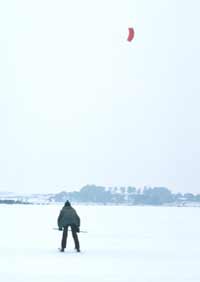
Skiing with our first Flexifoil
In the autumn of 1977, before I actually built anything, I found that Ian Day, sailing friend and erstwhile keen dinghy crew, was playing with large kites just for fun. He jumped at the idea of trying to make them work as sailpower. He modified his kite several times, attempting to get a good mix of power and control, but it was never very satisfactory.
Then another sailing friend, Martin Rayment, saw a short piece on TV about a new stunt kite called a "Flexifoil", which appeared to have the right characteristics. We bought one and found that it was superb in a good breeze, controllable and powerful round to about 70 degrees off the downwind direction. We tried it as power for Ian's Finn dinghy - while obviously very underpowered with only about 12 sq ft of area we deemed the trial successful. So we obtained about a dozen of them to make a decent stack.
We immediately hit the next problem: How do you actually control a big stack of Flexifoils? The 6 ft span retail kites were sold with a wooden bar to hold, with the two strings tied to the ends. If we added a couple more kites the forces became too much to hold in any breeze, and of course the supplied cord broke. We were soon using polypropylene rope (it floats!) with a breaking strain about 1000 lb. On land, we experimented with various pivoted stainless steel bar arrangements. I had the idea that it should be possible to make the control semi-automatic for a given course or off-wind angle, but never achieved it reliably! And even under continuous hand control the forces were too great for comfort. So we built a simple winch with a divided drum. The kite strings were passed through two pulleys for alignment and the tails wound on the drums in opposite directions, to balance out the main force. The extra leverage of the winch handle made it all quite manageable with a bit of practice.
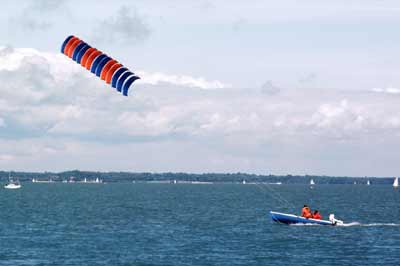
The Flexifoil rig on Ian's Finn dinghy. The outboard is NOT powering the boat!
In spring 1978, this rig was mounted on the Finn dinghy hull and a small outboard motor added as reserve for getting home, since we have quite strong tides in the Western Solent! We anchored to windward of the shingle spit at the mouth of Keyhaven harbour and assembled the rig, upside down, on the beach. With Ian at the kite winch, the rig was flipped over and soared up into the air. He "parked" the kites as near straight above as possible, where the horizontal pull on the boat was minimum. I waded aboard and released the anchor line as Ian guided the kites to one side to start driving the boat.
Away we sailed, and it was immediately obvious that we had something interesting! The Finn is normally a single-handed boat, but the kite rig took all Ian's attention so I was aboard to steer. Despite the extra weight, the bows rose and the little boat took off like a scalded cat, seeming much faster than it had ever gone before. We had good directional control as well, getting within perhaps 50 degrees of the wind. The only lack was that we couldn't actually "tack" as normal, and had to "wear ship" by spinning round to leeward. And, of course, if we dropped the kites in the sea we had to drag the wet mass on board and motor back to the beach.
With a little practice we became quite confident with our strange rig. Provided the wind stayed fresh, we could go where we liked in reasonably open water. We soon learned to sail back into the harbour and land the kites back on the beach where they started. We also light-heartedly took part in a few Club dinghy races; we were a bit slow upwind but swept past the opposition on the reaches and runs.
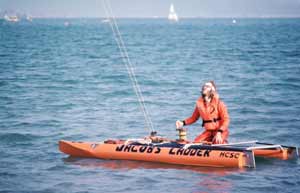
Jacob's Ladder I sailing at Keyhaven, 1978
However, it was obvious that the Finn was not suitable for record-breaking. So during the summer of 1978 we built a crude but lightweight 12 ft catamaran of tortured 3mm ply. A new boat needs a name and, as the rig formed a ladder to the sky, we called her "Jacob's Ladder". In theory she was to be just large enough to carry us both, but in practice was much too crowded. As Ian was now skilled at flying the rig, he was voted to sail the boat single-handed. This was quite hairy; the rig was a full-time job, so steering sometimes took second place, with interesting results.
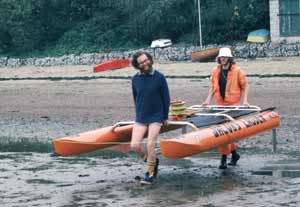
Launching Jacob's Ladder I at Portland, 1978
Crude measurements indicated that we were getting speeds between 15 and 20 knots, so we decided to enter for the Speed Week in the autumn. But before that a new member of the team, Neil, arranged to show the boat on the Mercantile Credit stand at the Southampton Boat Show, where it attracted a lot of interest.
During practice a recurrent problem occured when we landed the rig back on the beach: The spars in the early Flexifoils were hollow; when they hit the shingle some would crack and fail. This had not happened during trials over grass on land. Flexifoil not only replaced those spars but also provided a new rig with solid spars which were much more robust, if a little heavier.
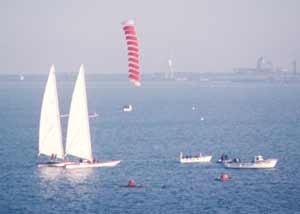
Jacob's Ladder I with Crossbow at Portland, 1978
And so to Portland for Speed Week 1978. We broke no records, but it was valuable experience. There were several problems: First, there was hardly any wind all week; second, it was hard to find enough space on the little beach at Castle Cove to launch our rig; third, we had to get permission from the nearby Naval Air Station, HMS Osprey, whenever we wanted to fly the kites. The latter two combined to prevent our launching in the one period when there was a decent breeze! However, we did sail most days and proved to some doubters that we could usually go where we wanted. I think our best timed speed was about 7 knots. We were not too disheartened. We had sailed and posted a time, whereas among the many weird and wonderful craft were several, even from as far as Japan, who had not managed this. There was a French entry, complete with hydrofoils, that wouldn't float when placed in the water!
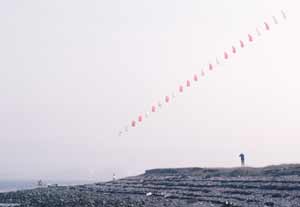
A big kite stack in light breeze, Portland 1978
In 1979 there were further developments, not always directly towards record breaking but following on from earlier publicity. For example, we were invited to give a talk at Southampton University aerodynamics department. This was illustrated with slides and also 8mm film. The film of Ian sailing single-handed, executing the "wear ship" manoeuver at full power, caused great amusement, particularly to Tony Marchaj, a guru of sailing aerodynamics.
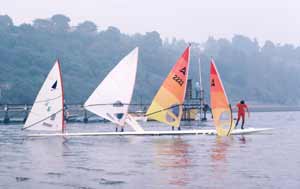
A 4-man sailboard from France, Portland 1978
We also arranged a demonstration for a research group from BP who were investigating alternative propulsion for ships. At this time Flexifoil had provided us with a set of 10ft span kites and we set up the rig on my 26ft Telstar cruising trimaran, so that there would be space for all aboard. An initial trial in a good breeze broke the control winch, due to the extra weight of the boat! It was hurriedly replaced with a more robust item based on a yacht winch, but on the demonstration day the wind was light. We managed to launch the rig, however, and sailed two circuits of the western Solent. Our visitors came equipped with a handheld windspeed meter; on the downwind legs, with the boatspeed showing 8 knots, the wind meter showed zero! The kites, higher up, were in somewhat better breeze and were flown from side to side in a figure 8 pattern to keep their apparent wind as high as possible. We heard later that Flexifoil were to provide BP with a rig of 20ft kites for further trials, and hoped we might be involved, but nothing further came of it.
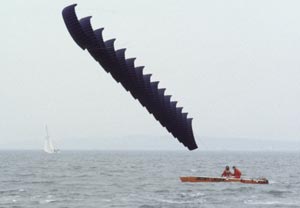
Jacob's Ladder II at Keyhaven
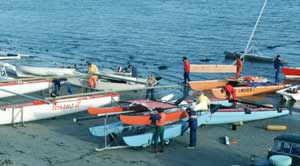
Castle Cove beach, Portland 1979
We came to the conclusion that we must have a two man boat for the speed trials, so that Ian could give his whole attention to controlling the rig, and we obtained an elderly Tornado catamaran in August. This was duly renamed "Jacob's Ladder II", rigged with the kites and the small "get-you-home" outboard. We practised often; I particularly recall one foggy day with strong breeze in Hurst Narrows when Ian was determined to apply full power despite my cries of "power off!" as we jumped over the lumpy waves. We sailed through the lee of a large ketch which had an enclosed cockpit with weather canvases all buttoned up. He suddenly became aware of this catamaran overtaking him with no visible means of propulsion; the covers popped open and his gaze followed the lines up into the sky!
Speed Week 1979 suffered much the same lack of wind as '78, and we had the same problems as before. We were entered in "C" class, for sail area up to 300 sq ft, which meant we could use 14 of the 10ft Flexifoils. This seemed the "softest" record and had the fewest other entries. We recorded a speed around 14 knots. Sailing at Portland showed up the advantages of Keyhaven, where we could find a lee shore to launch the rig in most wind directions by achoring on the appropriate side of the shingle spit. Without that flexibility at the trials, we determined to find a way to launch the rig from a weather shore.
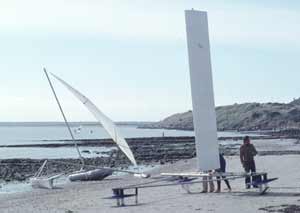
French entries, Portland 1979
For 1980 we had solved the weather shore launch after a fashion, but the operation was rather fraught. The boat was double anchored to resist both on- and offshore pulls. The lines were led ashore and doubled back through a pair of snap-blocks attached to a long rope made off on a winch. The kite section of the rig then lay downwind of the snap-blocks. When launched, Ian had to control the kites from the "wrong" side compared with his normal view. We then gradually payed out the long rope until the rig was flying from the boat as normal and the snap-blocks were disengaged. The force on the long rope was tremendous, up to double the kite pull, and soon the rope surface melted due to friction and stuck to winch. The heavy plywood panel holding the winch then gave way, and the assembly was catapulted way over Ian's head and into the harbour! We replaced the panel and winch with an artistic length of stainless tube, around which the rope was wound in a spiral. This gave better control of the friction and improved heat dissipation. The boat itself was unmodified apart from giving Ian anchorage lines to tie himself down so that he could use both hands on the kite winch without sliding around on the trampoline deck. Our best speed was about 19 knots but we could now see the limitations of the Tornado hull. At that speed she would squat back with the bows in the air, develop severe lee helm and become difficult to steer. This wouldn't happen under conventional rig due to the forward pitching moment of the mast and sails. Nonetheless we were close to the top speed of conventional Tornados.
One helpful advance was that we no longer had to get permission from the Navy before launching. Early in the week we phoned as before; the Officer of the Watch replied: "Don't keep ringing us - if my pilots can't keep clear of your kites they shouldn't be flying!"
And as a pleasant conclusion we were awarded the Design Prize by the Amateur Yacht research Society.
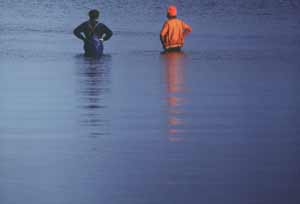
Waiting for the wind!
During 1981 I modified the hulls to give a flat run aft to prevent squatting, and moved the centreboards forward of the main beam to prevent lee helm. This was successful and we pushed our speed up to about 24 knots that autumn, within a fraction of a knot of the C class record. During that run the boat was skipping in and out of the water. As we were reaching across the wind with the kites well out to one side, when we left the water she would suddenly accelerate bodily sideways downwind. When she re-entered the water she abruptly ceased moving sideways and accelerated forward again, giving a very jerky ride. Just as we crossed the finish line she took right off; I was left sitting in mid-air as she went sideways about 6ft up. Then she crashed, bows first, many yards away as I bounced along the surface. Ian was flung forward over the main beam and dragged, with his head underwater, until the rig crashed into the sea and all came to a standstill. He felt he had nearly drowned. Our tender, manned by Martin and Tim, was soon on the scene.
The effect of all that was too much for my suspect back, and I relinquished the helm to Martin who already had some practice at Keyhaven. A day or two later they attempted to sail in very strong wind. As the long line was fed out and the rig came above the boat, she started lifting out of the water while still anchored. Martin got aboard, but then a stronger gust came and she lifted to such an angle that he fell off. Ian clung on, trying to keep the kites stationary to reduce the forces to a minimum. The boat was hanging vertically when the anchor warp broke. Ian was left behind as she rose over 30ft in the air before crashing violently in the sea many yards to leeward, with rather a lot of damage.
All this provided great copy for the assembled media, but it was the end of our part in Speed Week for that year, but we did receive a special award of the Altitude Prize!
Martin took over urgent rebuilding of the boat, as he and Ian were due to take her to the Brest Speed meeting a week later. One bow needed major repair, and he narrowed the area of our flat run on the hull aft because we felt there was a tendency for waves to kick the stern up when she hopped out of the water at speed.
And so we assembled at Portland again in autumn 1982. With a fine breeze blowing the beach was very crowded with expectant onlookers as we prepared to launch. Knowing the dangers of the launch phase, I was rather short with people getting in the way. A well known journalist asked "What are you going to do now?". Luckily, Ian intervened to say "Well, we're all ready and the wind is right, so we should break the record!". And that's exactly what they did, reaching just over 25 knots, to the gratification of the whole team. I remember Tim coming along the beach, before any official announcement, with a big grin saying "They've done it!".
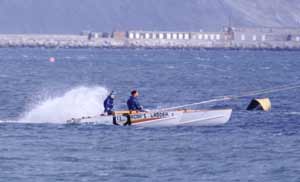
On foils, Portland 1983
After that I took a back seat in the campaign, so will only mention the main points that I recall.
For 1983 they fitted lifting hydrofoils to the same hull, hoping for a smoother, faster ride, but couldn't improve the speed.
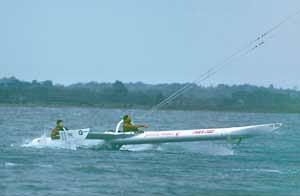
Jacob's Ladder III at Keyhaven
In 1984 Ian obtained sponsorship from Plessey and Johnny Walker to build a new boat. This was a single hulled flying hydrofoil, with hydraulically controlled side foils on outriggers and a combined lifting and steering foil under the bow. New team member Mike Urwin with Martin and I were working for the same firm (then called Wavepower Ltd, but building blades for wind turbines!) where they built the outriggers and foils of carbon and timber composites, working after hours. The 30ft hull was built by Steve Worf in strip cedar/epoxy. Mike developed the hydraulic control for the side foils, which would enable Martin to keep the boat upright while he steered with foot-pedals. The new boat was launched with due ceremony at Royal Lymington Yacht Club, with VIPs of Plessey, Johnny Walker and Wavepower present, and named "Jacob's Ladder III". But, as so often happens, by the time the new boat was ready there was little time to practice before Speed Week.
Ian avoided the main problems of launching the rig by hiring a long pontoon on which to lay out the kites. It was moored in a corner of the harbour and could be turned to line up with the wind. It did need three people to turn the kites over and get them airborne reliably, but was much preferred to the antics of the windward shore launch.
When sailing she looked impressive, often throwing up gratifying amounts of spray, but there were problems. After a short time afloat she seemed reluctant to lift onto the foils. At first we thought she must be shipping too much water from the spray, so the crew were equipped with "skirts" to seal their cockpits as used by canoeists. But the lack of lift continued and no better speed was attained.
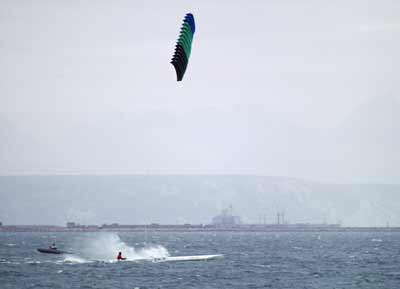
Jacob's Ladder III, Portland 1984
Over the next year she was fitted with a small extra central lifting foil to help her "unstick" from the water. This seemed to help a bit, but she still showed the loss of lift with time, requiring frequent returns ashore for the hydraulics to be adjusted. So again they were disappointed. But on one memorable day they did manage to capsize the boat when they inadvertently drove her backwards! Luckily both escaped from their constricted cockpits safely.
It was eventually realised that the loss of lift was due to slow internal leakage within the double-acting hydraulic cylinders controlling the side foils. This despite the fact that the whole system was pressurised and showed no external leakage. The only cure would be to make new cylinders with vented space between pairs of "O ring" seals on the double-acting pistons, so that all seals would be located firmly by the overall internal pressure.
However, due to professional and domestic pressures, the team could no longer give the commitment required to continue and the campaign came to close at about the same time that the RYA ceased holding an annual Portland Speed Week.













